Wayne Thiebaud Hamburger Counter 1961 oil on canvas 20 x 31 7/8 in. (50.8 x 81.2 cm) Signed and dated "Thiebaud 1961" lower right and on the reverse; further signed "Thiebaud" on the stretcher bar.
Provenance Patrick & Mary Dullanty, California, acquired directly from the artist Private Collection Sotheby's, New York, Contemporary Art Sale, May 11, 2006, lot 222 Acquired at the above sale by the present owner Catalogue Essay "People say painting’s dead. Fine. It’s dead for you. I don’t care. Painting is alive for me. Painting is life for me.” Wayne Thiebaud Wayne Thiebaud’s serene and delectable still lifes painted from 1961 to 1962 belong to one of his oeuvre's most important periods. As seen in the present lot, Hamburger Counter, 1961, the virtuous painter’s superb ability to capture the delicate skin of a tomato slice, the soft curve of a hamburger bun, and the cold and refreshing surface of a bottle is unrivaled. It was during this period that Thiebaud started producing some of his most emblematic works, after establishing his essential aesthetic: simplified geometric forms depicted, for example, in the relish, mayonnaise and mustard bottles in this work - painted in brisk brushstrokes and vibrant colors. These brushstrokes create a sensation of linear movement and the sparse background produces a strong lighting effect that is informed by theatrical spotlighting. It further points to a unique means of representation in which Thiebaud isolates each of the objects that he chooses to render on the hamburger counter and aligns them in strict progressions. This technique of representation is specific to Giorgio Morandi whom Thiebaud greatly admired. As we observe the painting in greater detail, we can see that the technique he uses on the surface of the ketchup bottle, dragging the paint across its body and around its shape, creates a texture that often transforms itself into the very material being depicted. Thiebaud adopts this technique from Willem de Kooning Richard Diebenkorn and David Park It is the subject matter of his still lifes, however, that provide insight into one of the fundamental contributions he has made to contemporary art: he proposes more than just visual pleasure and he distinguishes himself from the Pop movement by his subtext. Although one must not read too much into the symbolism of these still life paintings, Art critic Holland Cotter has accurately pointed out that these, “are personal documents [and] their surfaces are readable as diary entries.” Thus, in the case of Thiebaud, he has often stated that the food he has rendered time and time again in his work has an emotional nexus to his childhood memories. They reflect back on the family picnics where his family served home cooked meals, the food he saw displayed in drugstores, bakeries and hardware stores, as well as his memories of working in restaurants and small stores. However, the food he paints displayed in these bakeries and drugstores in his childhood home evoke something completely different to what Pop artists were trying to evince. The Pop movement satirized consumer society, mass production and advertisement, encoding an element of irony, which Thiebaud did not evoke through his works. On the contrary, the food depicted comments on the people who make it and enjoy it. Curator Steven Nash further states that the objects reflect, “an honest appreciation for aspects of [the] American experience.” One must also remember that Thiebaud had already begun depicting these signature subject matters and techniques (evinced in Hamburger Counter, 1961) as early as the 1950s, well before Warhol, Lichtenstein, and other related Pop artists. Geography also plays a pivotal iconographic and stylistic role in his works as he renders, in his still lifes, the childhood objects and memories from when he lived in Sacramento, California, in a modest neighborhood. This is drastically different from the Southern California iconography of palm trees, starlets, grand billboards and Hollywood openings. It was precisely this more austere background that gave him a physical and intellectual distance from the rest of American culture, and also granted him the
Wayne Thiebaud Hamburger Counter 1961 oil on canvas 20 x 31 7/8 in. (50.8 x 81.2 cm) Signed and dated "Thiebaud 1961" lower right and on the reverse; further signed "Thiebaud" on the stretcher bar.
Provenance Patrick & Mary Dullanty, California, acquired directly from the artist Private Collection Sotheby's, New York, Contemporary Art Sale, May 11, 2006, lot 222 Acquired at the above sale by the present owner Catalogue Essay "People say painting’s dead. Fine. It’s dead for you. I don’t care. Painting is alive for me. Painting is life for me.” Wayne Thiebaud Wayne Thiebaud’s serene and delectable still lifes painted from 1961 to 1962 belong to one of his oeuvre's most important periods. As seen in the present lot, Hamburger Counter, 1961, the virtuous painter’s superb ability to capture the delicate skin of a tomato slice, the soft curve of a hamburger bun, and the cold and refreshing surface of a bottle is unrivaled. It was during this period that Thiebaud started producing some of his most emblematic works, after establishing his essential aesthetic: simplified geometric forms depicted, for example, in the relish, mayonnaise and mustard bottles in this work - painted in brisk brushstrokes and vibrant colors. These brushstrokes create a sensation of linear movement and the sparse background produces a strong lighting effect that is informed by theatrical spotlighting. It further points to a unique means of representation in which Thiebaud isolates each of the objects that he chooses to render on the hamburger counter and aligns them in strict progressions. This technique of representation is specific to Giorgio Morandi whom Thiebaud greatly admired. As we observe the painting in greater detail, we can see that the technique he uses on the surface of the ketchup bottle, dragging the paint across its body and around its shape, creates a texture that often transforms itself into the very material being depicted. Thiebaud adopts this technique from Willem de Kooning Richard Diebenkorn and David Park It is the subject matter of his still lifes, however, that provide insight into one of the fundamental contributions he has made to contemporary art: he proposes more than just visual pleasure and he distinguishes himself from the Pop movement by his subtext. Although one must not read too much into the symbolism of these still life paintings, Art critic Holland Cotter has accurately pointed out that these, “are personal documents [and] their surfaces are readable as diary entries.” Thus, in the case of Thiebaud, he has often stated that the food he has rendered time and time again in his work has an emotional nexus to his childhood memories. They reflect back on the family picnics where his family served home cooked meals, the food he saw displayed in drugstores, bakeries and hardware stores, as well as his memories of working in restaurants and small stores. However, the food he paints displayed in these bakeries and drugstores in his childhood home evoke something completely different to what Pop artists were trying to evince. The Pop movement satirized consumer society, mass production and advertisement, encoding an element of irony, which Thiebaud did not evoke through his works. On the contrary, the food depicted comments on the people who make it and enjoy it. Curator Steven Nash further states that the objects reflect, “an honest appreciation for aspects of [the] American experience.” One must also remember that Thiebaud had already begun depicting these signature subject matters and techniques (evinced in Hamburger Counter, 1961) as early as the 1950s, well before Warhol, Lichtenstein, and other related Pop artists. Geography also plays a pivotal iconographic and stylistic role in his works as he renders, in his still lifes, the childhood objects and memories from when he lived in Sacramento, California, in a modest neighborhood. This is drastically different from the Southern California iconography of palm trees, starlets, grand billboards and Hollywood openings. It was precisely this more austere background that gave him a physical and intellectual distance from the rest of American culture, and also granted him the
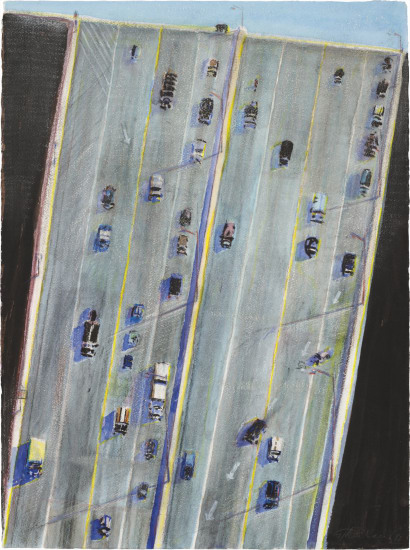
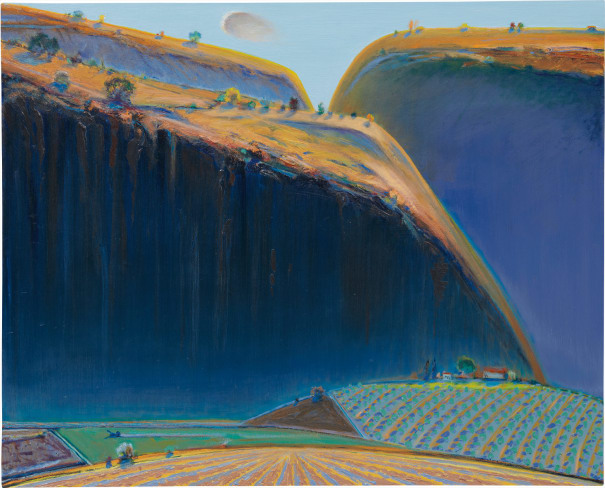
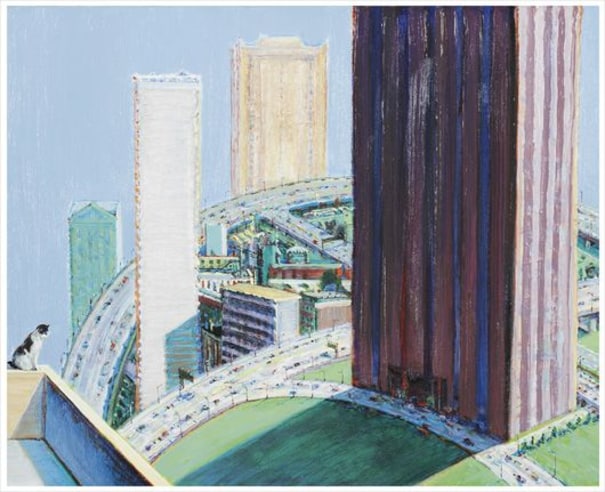
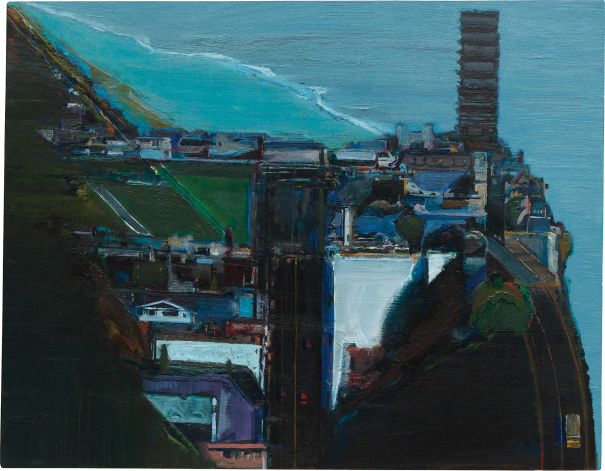
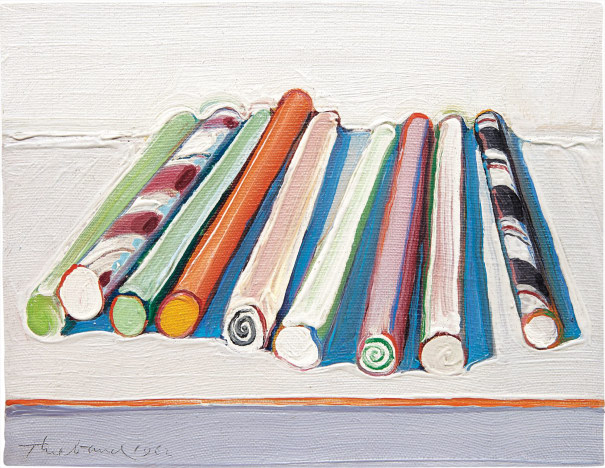


.jpg)
.jpg)


.jpg)


Testen Sie LotSearch und seine Premium-Features 7 Tage - ohne Kosten!
Lassen Sie sich automatisch über neue Objekte in kommenden Auktionen benachrichtigen.
Suchauftrag anlegen